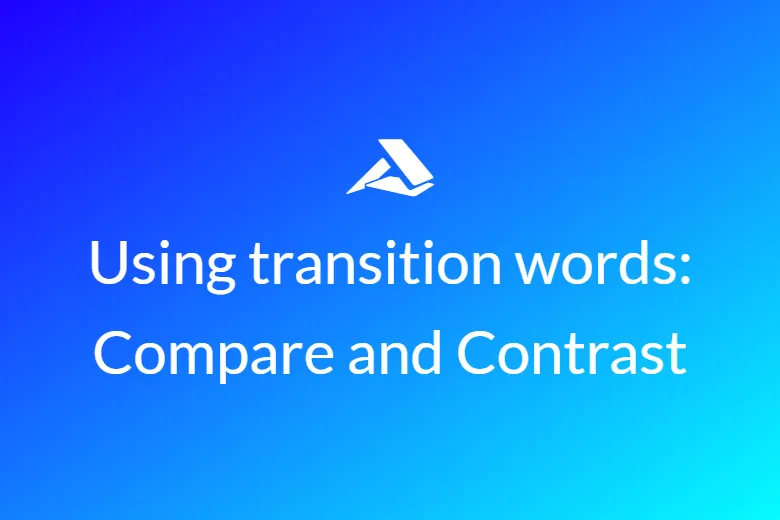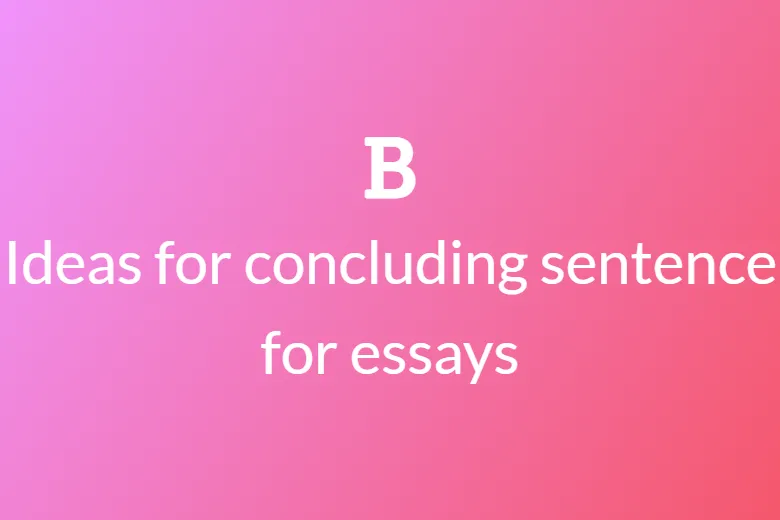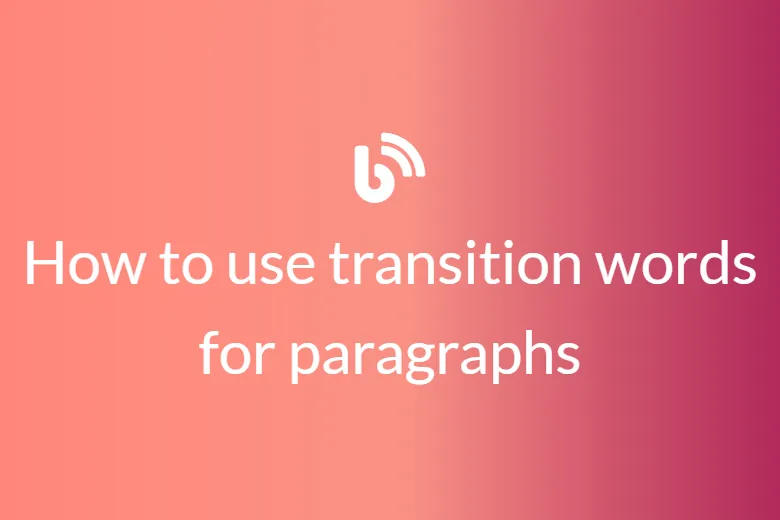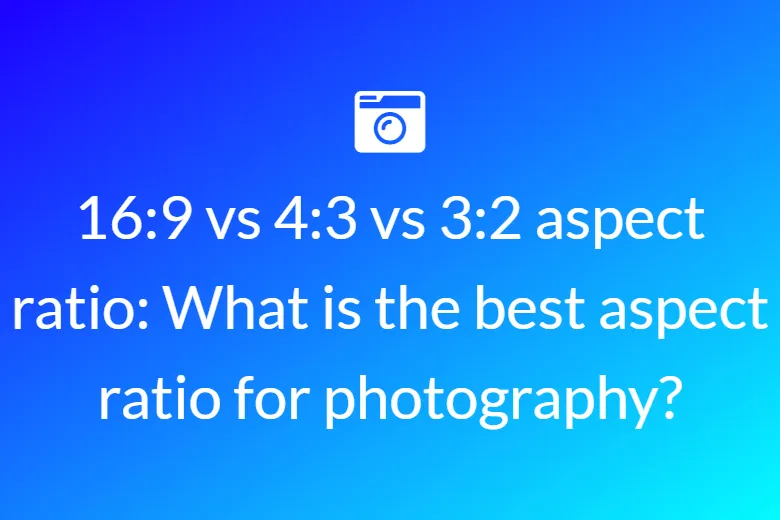Using appropriate transition words in sentences
Transitional words and phrases help make a piece of writing flow better and connect one idea to the next. These words make your text easier to read and understand. These words are like, ‘But’, ‘So’, ‘And’ & ‘Because’, etc. Transition words make your sentences better to understand. When you put your thoughts and ideas into sentences and use transition words in between, it actually helps your text flow more readable.
However. Based on the type of transition you want to make. Transition words are divided into various categories. It may be possible that one transition has several other words, but not necessarily the same meaning because there’s more than one way to connect ideas, there are many types of transitional phrases to show a variety of relationships.
Moreover, Using transition words in your writing can help you enhance the readability of your content. These words help your text flow and show readers the relationship between phrases and paragraphs. But what are they exactly? Why are they so important? And how should you use them? View several examples of transitional words and phrases used in sentences.
What are transitional words and phrases?
The most basic used transitional words or conjunctions that we often use are, “and,” “but” and “or” to connect two sentences together. Let us see some familiar examples to understand how these words are used:
1.I ran to the park, and I just got there on time.
2.I ran to the park but was still late. As you can see in the examples above, even simple conjunctions serve different purposes.
- The first sentence uses “and” as a transition word that connects the two occurrences equally.
-
The second sentence uses “but,” which introduces a contrast.
Knowing what kind of transition words to use comes in handy and helps you to get your point across. These words show the relationship between the phrases, paragraphs, and sentences that we write. Using this kind of word makes it easier to read our texts and understand them in a better manner. Let us see some examples to understand this better:
I pushed the domino. As a result, it fell over.
When you start a sentence with ‘as a result, your reader will immediately know two things:
- What happened in the first sentence caused something;
-
The second sentence is going to describe the effect.
By using the phrase ‘as a result here, you show that the two separate sentences are part of one process. Without reading the whole sentence, your potential reader can well in advance guess what is likely to come next. We can also say that these transition words are like a glue that holds our sentences together. With them, the individual parts come together to form one whole. Transition words don’t always have to be placed at the beginning of a sentence. Consider the following example.
Harsil is a very nice guy. He took us out to dinner yesterday, for instance.
In this example, ‘for instance, is placed at the end of the sentence. Nonetheless, it still provides the reader with information as to how the two sentences are related.
I enjoy his company because he always tells interesting stories.
In this example, ‘because’ doesn’t connect two sentences, but two clauses. Transition words can connect anything from short phrases to entire paragraphs.
Adverb transition words - Other transition words are adverbs that describe the way an action is performed or how it relates to another idea. For example:
- I went to the waterpark after he gave me my paycheck.
- Bowling is a sport in which the player with the highest score wins. Conversely, the goal in golf is to get the lowest score.
- to get the lowest score.
Types of Transition words


Examples Of Transition Words In Sentences
Comparison/ Contrast
- Likewise, she thought we went to Shimla.
- Similarly, He did not like rice.
- On the contrary, he is a pure Vegetarian.
Cause/Effect
- Therefore, she was suggesting me.
- As a result, we both stuck.
- Because they exercise daily, they are happy.
- Since you have studied well, you will get good marks.
Chronology
- Later, you’ll be upset, you did.
- You’ll be able to simultaneously read and write.
- During your journey, you were so energetic.
- Before you eat food, make sure you have to wash your hands.
Addition
- That jewelry is beautiful; moreover, it is costly.
- Furthermore, their observation was right.
- Jack is handsome, intelligent, and also confident every time.
Illustration/ Examples
- Specifically, she loves vanilla brown sugar brownies.
- To demonstrate her interest in cooking, John brings many recipe books for her.
Qualification
- Possibly, they will complete the task.
- They almost reached there.
- With this in mind, now you can do preparation.
Classification
- In other words, You can do far better than this.
- To put it another way, she is the combination of beauty with the brain.
- She is always sitting on the top of my mind. That is irritating all the time.
Summary/Conclusion
- In the long run, those plans will be beneficial.
Understanding transition words using everyday examples
Text A
I’m going to discuss a few reasons why practice is important to learning skills. The only way to truly master a skill is by actually doing what you’ll have to do in the real world. I think practice can be a fun way of putting in the necessary hours. There are some people who will disagree. It is said that people tend to remember only 10-20% of what they’ve heard or read. That number rises to as much as 90% when you put theory to practice. Following up an explanation with practice is key to mastering a skill.
Text B
In this paragraph, I’m going to discuss a few reasons why practice is important to mastering skills. Firstly, the only way to truly learn a skill is by actually doing what you’ll have to do in the real world. Secondly, I think practice can be a fun way of putting in the necessary hours. There are, however, some people who will disagree. Thirdly, and most importantly, it is said that people tend to remember only 10-20% of what they read or hear. Moreover, that number rises to as much as 90% when you put theory to practice. In conclusion, following up explanation with practice is key to mastering a skill.
Text A though not a bad paragraph lacks the finesse of Text B. ext B does a better job of showing there are three separate arguments to support the statement with a definite conclusion. Readers are going to be more intrigued while reading Text B as compared to the contents in Text A as the latter explains in a better manner.
Tricks to improve: smooth experience in transition writing
Creating a smooth writing experience is like maintaining a bicycle chain. When your chain gets muddy, it starts to squeak and rattle. Pedaling becomes harder. And perhaps the chain might even drop off. In order to have a smooth riding experience, you first remove the dirt from your chain, and then apply lubricant to reduce friction and prevent rust. When editing your content, you do exactly the same. First, you remove the dirt from your content—you eliminate unwanted words and replace weak words. And then you apply writer’s lube—which is the transitional tricks for a smooth reading experience.
Transition trick #1: Drops of light oil
Much the same as drops of oil make your bike chain move without friction, transitional words make readers glide through your content.
Transitional words make the reading experience smoother since they clarify the connection between two sentences. Instances of temporary words are:
- And
- But
- Or
- However
- In contrast
- Because
- For instance
- So
You can either use transitional words at the beginning of a sentence to explain the relation with a previous sentence or to connect two parts of one sentence. Here’s an example:
She has ideas to share, but nobody listens
Sometimes, you want to shout, Hey you listen!
Now read these sentences aloud and you will notice how abrupt these phrases are. Your writing requires little variation in order to sound interesting. Now let us remove the transitional words and read again.
She has ideas to share. nobody listens
You want to shout, Hey you listen!
Transition trick #2: Like changing gears. Yes, just like in cycling, in writing you often move up or down a gear. For instance, in your introductory paragraph, you’ve explained to your reader that you have understood the problem and will aim to solve it. To indicate the start of the section with tips, use a short and engaging question:
Are you ready to get started?
Does this sound good?
Shall we begin?
Therefore, addressing your readers with short questions makes your content conversational and engaging, and it encourages your readers to read on.
Transition trick #3
A few years ago, I bought a new bicycle. But each time I cycled uphill and changed gears, the chain fell off. To sort out this chain frustration, I now have a rubber dog fang. The dog fang prevents the chain from falling off. Similarly, we need such dog fangs in our writing too.
Keep your reader intrigued with short phrases like:
Let me explain why
And now comes the best part
Not only that
What’s more
Even more importantly
Transition trick #4: The Connectors
The secret involved in successfully moving from topic to topic without losing your readers or listeners is word connectors. Word connectors are words that are repeated subsequently in many sentences.
A coke quenches your thirst and appears to give energy, but its nutritional value is low. A fruit smoothie sounds healthy but may have a ton of added sweeteners.
Similarly, words with low nutritional value will seem to have a meaning, but their meaning is not quite strong.
Therefore, repeating a variation of the phrase “low nutritional value” helps readers move to the next topic.
Transition trick #5: Using Pronouns
Pronouns (words like they, it, he, her) play a similar role as word connectors, but you have to be careful what or whom the pronoun refers to.
For example, The kid was angry with her mother because of her ice cream. Instead, let us try to write, The kid was angry because she had only one scoop of ice cream, and her mother took three scoops. Ambiguity confuses readers and makes them stop to consider your message. Hence we should be clear so that our readers glide through the text effortlessly.
Transition trick #6
Bicyclists can argue for hours about the best way to keep your bike chain free from rust. Use Tri-flow. Use light oil. Re-lube more often. Hence, your content also needs a mix of tricks for the smoothest reading experience.
Make sure your subheading arouses curiosity or promises a benefit for the readers. When your reader’s mind starts to wander off, a startling subhead intrigues him back. It encourages people to keep reading and move on to the next topic with great agility.
Transition words play a crucial role in building your text. Transition words or phrases help the reader to understand the relationship between one idea to the next. It indicates exceptions, comparisons, examples, and sequences. You also need to use transition words properly for better understanding. Like knowing the proper words and having a clear idea about your text & how to use them properly.
- Know the words- Having proper knowledge of transition words helps your text be more readable. It is also necessary that what and where you should use transition words. You might have seen the text without transition words. Those sentences or text are not even readable and difficult to understand at the same time. For better knowledge of transition words make a list of transitions available.
- Having A Clear Idea Of Thoughts- Before writing any text you must be aware of your thoughts and ideas, Knowing what you wanna write and how to execute it properly is also very crucial. If you have proper knowledge of the structure of your text then you will also know about transition words. Using your thoughts as a write-up will help you to write more realistic content and understand it.
- Know-How To apply Transition words- Having knowledge of transition with the proper idea of applying it makes it more valuable. Using proper transition words helps you to enhance the chances of more readability. Transitions help you achieve to express knowledge by making connections between sentences and Paragraphs.
- Avoid Mistakes- Avoid as many mistakes as you can. Use the right transition word at the right place. Using the wrong words makes your reader confused and unable to understand your content.
- Use Logical Transitions- Every transition word has its unique meaning. Improper Knowledge of transition words and using them in a sentence can change its meaning and confuse your point that you want to understand your reader.
- Transition Overuse- Using transition words in between your text can be beneficial but using them again & again can often create confusion and difficulty to read.
Conclusion
Transition words are therefore very important for the readability of your text. However, most people struggle in successfully implementing them. If you do practice them, you will be effortlessly able to use them in your phrases.
However, overuse of transition words can make your text confusing. Transition words can create a strong connection between your ideas and thoughts on paper. Transition words help readers to understand your ideas by making your content readable.
Furthermore, choosing the right transitions that match the logic of your text is also very important, make sure whatever transitions you are using, it’s always the right match for your paper’s logic. Secondly, avoid using too many transition words, as it makes your text over-explaining and makes the reader lose interest.









